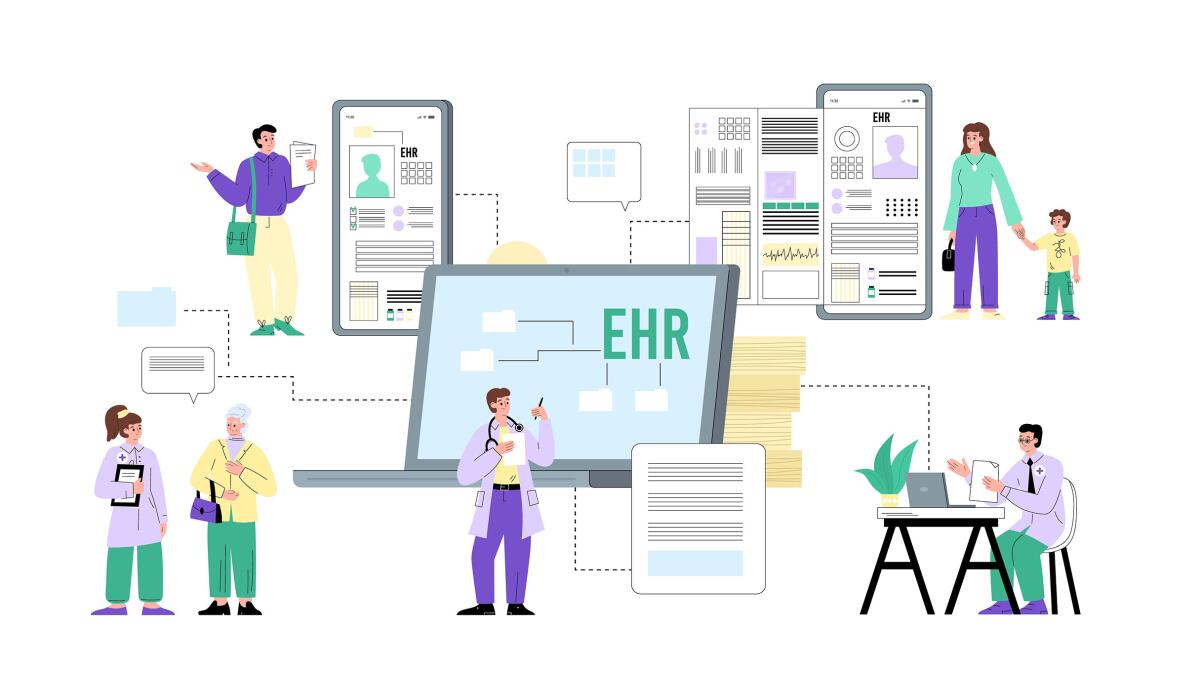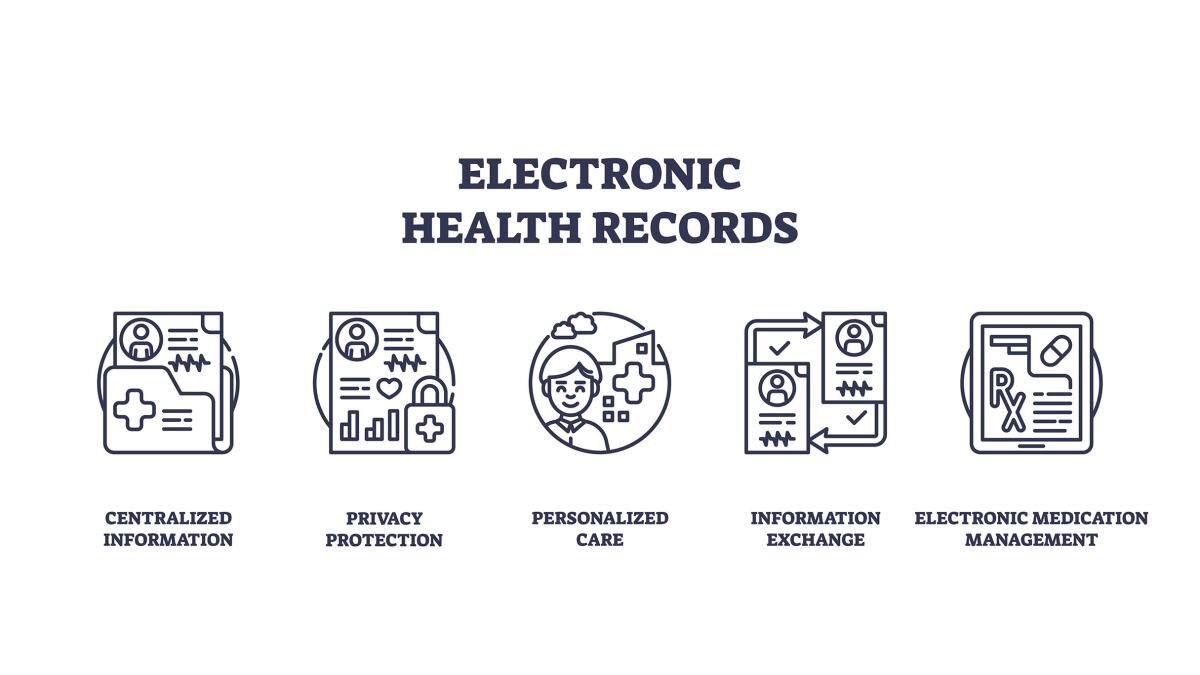How Healthcare Systems Are Strengthening EHR Security

- Share via
Key Facts
- Role-based access control (RBAC) restricts access to patient data based on job responsibilities, reducing risk.
- Encryption methods like symmetric and asymmetric key schemes safeguard sensitive health data in EHRs.
- Blockchain’s decentralized structure offers tamper-proof recordkeeping, though adoption is still limited.
- New methods like hyperchaotic encryption hide EHRs in images for covert yet secure data transfer.
- Users value transparency and control in cloud-based EHR platforms, influencing system trust and adoption.
Electronic Health Record (EHR) systems are the backbone of modern healthcare. With the widespread EHR adoption driven by legislation like the HITECH Act and 21st Century Cures Act, providers globally are using them more than ever. They make it easier for clinicians to access patient data, coordinate care and improve outcomes.
But with those benefits comes a big question—how do we keep that data safe? With cyber threats increasing and sensitive health info on the line, EHR security is more important than ever. Luckily providers are using a mix of old and new to protect patient privacy and trust.
Table of Contents
- What are Electronic Health Records?
- Benefits of EHR Systems
- Key Security Measures and Technical Safeguards
- Administrative and Physical Safeguards
- Health Data Management
- Health Information Exchange
- Innovative Approaches
- EHR Systems Future
- Closing Thoughts
- References
What are Electronic Health Records?
Electronic Health Records (EHRs) are a digital version of a patient’s medical history including demographics, medical and treatment history, lab results, and clinical notes. EHRs have changed the way providers manage patient data, making care better and more efficient. With EHRs providers can access patient info quickly and easily reducing the risk of medical errors and improving patient outcomes.
EHRs have streamlined clinical workflows for healthcare organizations allowing for more coordinated and effective care. By centralizing patient data EHRs allow providers to make informed decisions leading to better health records management and improved treatment outcomes.
Benefits of EHR Systems
The benefits of EHR systems are many from better patient care to increased operational efficiency and better data security. EHRs give providers immediate access to patient information so they can make informed decisions about patient care. This quick access to data reduces the risk of medical errors and patient safety.
EHRs also minimize administrative tasks like paperwork and data entry so providers can spend more time on patient care. EHRs make data more accessible and shareable among providers leading to better collaboration and care. Plus EHRs have been shown to improve health outcomes by providing a complete picture of a patient’s medical history and treatment history which is critical for accurate diagnosis and treatment planning.
Key Security Measures and Technical Safeguards
Access Control: One of the first lines of defense in EHR systems is limiting who can get in. Access control—especially when fine-tuned by roles and responsibilities—helps prevent unauthorized entry. A cross-country study found that strong access control on workstations was associated with a 44% lower chance of technical interoperability issues [6]. That’s not just about safety—it also keeps the system running smoothly.
Encryption and Cryptography: Data encryption scrambles sensitive information so that only authorized users can make sense of it. Healthcare systems typically use a combination of symmetric (shared key) and asymmetric (public/private key) encryption to protect records. Think of it like sealing a letter in a locked box—only the right key can open it.
Digital Signatures: Digital signatures ensure that EHR data hasn’t been tampered with. This helps prove authenticity and prevents repudiation, meaning users can’t deny their actions later.
Role-Based Access Control (RBAC): RBAC assigns system privileges based on job roles. For instance, a nurse may only see certain patient data, while a physician has broader access. This targeted limitation reduces exposure to data breaches and keeps confidential information in the right hands [2].
Clinical Decision Support: Clinical decision support within EHR systems enhances security and functionality by automating the monitoring of clinical events. It improves care efficiency, reduces medical errors and provides healthcare professionals with necessary data insights and alerts during patient care.
Administrative and Physical Safeguards
Staff Training: Even the most secure system can be undone by human error. That’s why continuous education around privacy, security practices and cyber hygiene is key. Well-trained staff are less likely to fall for phishing scams or mishandle data [3].
Regulatory Compliance: To stay aligned with legal and ethical standards, healthcare organizations must comply with data privacy regulations like HIPAA in the US and the European Data Protection Directive 95/46/EC [2]. These laws help guide how patient information is handled and shared across systems. Plus legal limitations under regulations like HIPAA can restrict the sharing of certain types of demographic data which can impede the development of multi-source electronic health record (EHR)-based registries. [4]
Health Data Management
Health data management is a critical component of EHR systems, involving the collection, storage and analysis of patient data. EHRs store a vast amount of data including demographic information, medical history, laboratory test results and clinical notes. This data is essential for clinical decision making, patient care and health outcomes [5].
Effective health data management ensures the accuracy, completeness and security of patient data which is vital for the integrity of the healthcare system. EHR systems must be designed to maintain the confidentiality, integrity and availability of patient data while providing healthcare providers with access to the information they need. By ensuring patient data is accurate and available EHR systems support high quality care and better health outcomes.

Health Information Exchange
Health Information Exchange (HIE) is the process of sharing patient data between healthcare providers, organizations and systems. HIE is critical to ensure patient data is available to healthcare providers when and where it is needed to improve the quality and efficiency of care. EHR systems play a key role in HIE by enabling the secure and electronic sharing of patient data. [10]
HIE can take many forms including direct messaging, query-based exchange and document-based exchange. Implementation of HIE has been shown to improve patient care by providing healthcare providers with a more complete view of a patient’s medical history, reducing medical errors and improving health outcomes. By facilitating data sharing HIE ensures healthcare providers have the information they need to deliver the best possible care. [9]
Innovative Approaches
Distributed Ledger Technology (DLT): DLT including blockchain introduces a decentralized and tamper-proof way of handling health data. Since each transaction (or data entry) is stored across a network of computers it’s almost impossible to alter records without leaving a trace. According to Healthcare (Basel) this makes blockchain a strong candidate for EHR security [1]. However high implementation costs and technical complexities remain barriers to adoption.
Advanced Encryption Techniques: A fascinating approach involves combining hyperchaos and image embedding. One study demonstrated a technique that encrypts EHRs and hides them in images – kind of like digital steganography. With a high payload capacity of 0.75 bits per pixel and a strong signal-to-noise ratio it offers promise for securely sharing data without making it obvious [7].
EHRChain Framework for Electronic Health Records: This dual-blockchain model uses both Hyperledger Sawtooth and InterPlanetary File System (IPFS) to distribute EHR data across multiple nodes. The EHRChain framework improves both security and accessibility and could solve some of the core interoperability issues in current systems [11].
Patient Data Perspectives
Technology is only half the equation—user trust is just as important. A qualitative study looked at how patients and providers felt about cloud-based, privacy-focused EHR systems. Users wanted control over their own data and needed to feel confident their information wouldn’t be misused or exposed [8]. Accurate patient identification is key to maintaining trust and data integrity. Trust, transparency and usability were the make-or-break factors for adoption.
EHR Systems Future
The future of EHR systems is bright with many developments on the horizon. One of the key trends is the increasing adoption of cloud-based EHR systems which offer more flexibility, scalability and security. Cloud-based solutions allow healthcare providers to access patient data from anywhere and provide more coordinated and efficient care. Another big trend is the integration of artificial intelligence (AI) and machine learning (ML) into EHR systems.
These technologies can analyze patient data to provide valuable insights to healthcare providers. Mobile devices and patient portals are also becoming more prevalent allowing patients to take a more active role in their care. Blockchain is being explored to enhance patient data security. As EHR systems evolve they will play a bigger role in improving patient care, health outcomes and reducing healthcare costs.
Closing Thoughts
Protecting patient data in EHR systems isn’t just about firewalls or encrypting files—it’s about building a security culture from the ground up. Traditional safeguards like RBAC and encryption will continue to play a critical role but emerging tools like blockchain and hyperchaotic encryption may redefine what’s possible. Ultimately the success of any EHR security system depends not just on the tech but on its usability and the trust it earns from the people who use it.
References
[1] Carlos Ferreira, J., Elvas, L. B., Correia, R., & Mascarenhas, M. (2024). Enhancing EHR Interoperability and Security through Distributed Ledger Technology: A Review. Healthcare (Basel, Switzerland), 12(19), 1967. https://doi.org/10.3390/healthcare12191967
[2] Fernández-Alemán, J. L., Señor, I. C., Lozoya, P. Á., & Toval, A. (2013). Security and privacy in electronic health records: a systematic literature review. Journal of biomedical informatics, 46(3), 541–562. https://doi.org/10.1016/j.jbi.2012.12.003
[3] Basil, N. N., Ambe, S., Ekhator, C., & Fonkem, E. (2022). Health Records Database and Inherent Security Concerns: A Review of the Literature. Cureus, 14(10), e30168. https://doi.org/10.7759/cureus.30168
[4] Rezaeibagha, F., Win, K. T., & Susilo, W. (2015). A systematic literature review on security and privacy of electronic health record systems: technical perspectives. Health information management : journal of the Health Information Management Association of Australia, 44(3), 23–38. https://doi.org/10.1177/183335831504400304
[5] Kruse, C. S., Smith, B., Vanderlinden, H., & Nealand, A. (2017). Security Techniques for the Electronic Health Records. Journal of medical systems, 41(8), 127. https://doi.org/10.1007/s10916-017-0778-4
[6] Shrivastava, U., Song, J., Han, B. T., & Dietzman, D. (2021). Do data security measures, privacy regulations, and communication standards impact the interoperability of patient health information? A cross-country investigation. International journal of medical informatics, 148, 104401. https://doi.org/10.1016/j.ijmedinf.2021.104401
[7] Aljuaid, H., & Parah, S. A. (2021). Secure Patient Data Transfer Using Information Embedding and Hyperchaos. Sensors (Basel, Switzerland), 21(1), 282. https://doi.org/10.3390/s21010282
[8] Alaqra, A. S., Fischer-Hübner, S., & Framner, E. (2018). Enhancing Privacy Controls for Patients via a Selective Authentic Electronic Health Record Exchange Service: Qualitative Study of Perspectives by Medical Professionals and Patients. Journal of medical Internet research, 20(12), e10954. https://doi.org/10.2196/10954
[9] Middleton, B., Bloomrosen, M., Dente, M. A., Hashmat, B., Koppel, R., Overhage, J. M., Payne, T. H., Rosenbloom, S. T., Weaver, C., Zhang, J., & American Medical Informatics Association (2013). Enhancing patient safety and quality of care by improving the usability of electronic health record systems: recommendations from AMIA. Journal of the American Medical Informatics Association : JAMIA, 20(e1), e2–e8. https://doi.org/10.1136/amiajnl-2012-001458
[10] Li, E., Clarke, J., Neves, A. L., Ashrafian, H., & Darzi, A. (2021). Electronic Health Records, Interoperability and Patient Safety in Health Systems of High-income [7] Countries: A Systematic Review Protocol. BMJ open, 11(7), e044941. https://doi.org/10.1136/bmjopen-2020-044941
[11] Pilares, I. C. A., Azam, S., Akbulut, S., Jonkman, M., & Shanmugam, B. (2022). Addressing the Challenges of Electronic Health Records Using Blockchain and IPFS. Sensors (Basel, Switzerland), 22(11), 4032. https://doi.org/10.3390/s22114032












